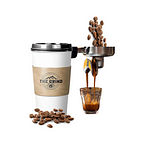A cup of coffee served just about anywhere around the nation might be tasting a bit more bitter in the coming months if things do not take a dramatic turn back to normal, and at this rate, we can assume bitterness.
The average American consumer has heard about supply chain issues and has felt rising costs, but hasn’t “truly” felt the squeeze since the great toilet paper war of 2020.
The federal reserve admits that inflation is running higher (5.4%) than it had anticipated, but that it expects it will curb in the future and consumer costs as well as raw material costs will level out, however, according to the fed, it naturally anticipates 2.3 percent inflation year-over-year. This means if the supply chain does finally level out in a reasonable amount of time, (two years in federal reserve time) then we are still left with 4.6% higher inflation by 2023, despite the fact we are on pace for a bit more than that at current — and with an absolute best case scenario of .8% lower inflation by the time we come out of this chaos, no one in the majority of industries are going back to pre-pandemic wholesale prices, which will need to be passed on to consumers as we are already seeing. See:
( 1] https://news.yahoo.com/inflation-hovers-5-4-july-123100359.html?fr=sycsrp_catchall ; 2] https://www.cnn.com/2021/05/08/business/supply-chain-shortages-pandemic/index.html ; 3] https://www.foxnews.com/politics/high-concern-over-higher-prices )
I cannot speak for other businesses, even though we talk regularly and I know what many are going through in making tough decisions when they are being promised from the economic top-down that prices will level out eventually, but I can speak for our business. When we purchased our first order of branded plastic cups in January, the price per cup at the bulk purchase we had made was fluctuating between .8 and.12 cents per cup and arrived in 1–2 weeks… today, that same cup is fluctuating between .29 and .34 cents per unit and is arriving in 8–9 weeks (3–6 months if you’re a new customer), forcing companies to buy up what they can when they can — thus exacerbating the issue. Corporations know something we do not yet realize, which is why a number of closely watched & scrutinized “economic indicating” companies (Harley Davidson, Whirlpool, General Mills, Pepsi, etc.) raising their prices is a very significant sign. They aren't doing it to protect themselves or investors for the final two quarters of 2021 or even the first of 2022, they are doing it because they know once everything truly levels out in 10–12 quarters, prices per unit will likely be no different. See:
(1] https://www.cnbc.com/2021/07/23/companies-from-chipotle-to-whirlpool-raise-prices-amid-inflation.html ; 2] https://www.msn.com/en-us/money/other/inflation-check-these-companies-are-raising-their-prices/ar-AAMvhCJ )
When these economy signaling companies make the decision to permanently raise prices 3–5+%, it also raises eye-brows across the market as well as small businesses as they begin to take note of the direction of the economy. Small businesses have always historically been the last to make the difficult decisions to raise prices, this is because of how inter-personal the decision is. When you’ve seen Fred every day for months or years, telling him he will have to pay more without the totality of the explanation behind it can potentially make the relationship bitter. When prices rise between 100% and 200% over night, and demand continues to sky-rocket as new businesses fill the shoes of those who sunk during the pandemic, raw material suppliers and wholesalers’ have no reason to lower their asking price and every reason to raise it even more to curb demand. See:
What’s more, not only do suppliers have a reason to keep prices inflated due to demand alone, but this isn’t the only factor pressing them and small businesses alike in a country which saw an astonishing 10 trillion dollars printed in the past year — which is demanding respect through inflation as well (infographic in sources below). In factory work, the majority of workers make more than minimum wage (https://www.indeed.com/career/factory-worker/salaries) so although the minimum wage hikes aren’t affecting them as significantly — they may as well be, because the labor shortage most certainly is. If these companies have any shot at filling the positions necessary to be able to meet demand for products, then they have to dramatically inflate starting wages to bring people on-board and keep them from going elsewhere. Like-wise, small business in some states are not just feeling the squeeze of inflation and shortages, but simultaneously juggling the minimum wage hikes which are naturally driving costs higher as well. The American worker most certainly will not accept being paid less in the future, therefor — naturally, we have little reason to suspect that suppliers will have the opportunity to lower prices if they have to pay a premium to keep labor on board. See:
( 1] https://www.businessinsider.com/us-labor-shortage-workers-hiring-chamber-commerce-jobs-emergency-2021-6 ; 2] https://www.epi.org/blog/minimum-wage-2021-increases/ ; 3] https://www.cnbc.com/2021/05/22/wages-rise-at-the-fastest-pace-in-years-firms-profits-could-take-a-hit.html ; 4] https://demonocracy.info/infographics/usa/us_stimulus_package_10_trillion_2020/us_stimulus_package_10_trillion.html )
So, in the event your cup of coffee costs a few cents more, or that small town diner charges you an extra buck or two, or maybe your favorite clothing store increases prices apologetically 10–15% — know that you aren’t lining the pockets of the rich and famous of Hollywood, but that those small business owners probably still didn’t raise prices enough out of fear of losing you, and will continue to take a small hit to their bottom line with the optimism that things will return to pre-pandemic costs, despite there being little evidence that it will.
NOTE: This article was typed as a way to help show the reasons that small businesses are making the decisions they are making, and as a way to help educate the consumer as to the current state of affairs. This is not in anyway meant to be political or politically affiliated, just to assist in having the conversation with consumers about why everything seems so out of whack.
